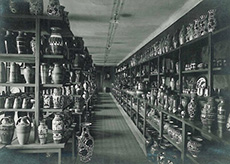The history of the zsolnay factory
overview
In Pécs in the 1850’s a ceramics factory, employing just a handful of people was established. The owner was the son of the respected Zsolnay family, Ignác, from whom the management of the factory was soon taken over by his brother, Vilmos. Vilmos Zsolnay succeeded in turning it into a high-quality factory in just a very short period of time.
Vilmos Zsolnay, who had painting ambitions, but became a businessman to follow his father’s wishes, started producing ceramics in the middle of the 19th century at the age of 25, with no previous experience. Not only de he have excellent taste and a great head for business, but he was also very receptive to technical innovations. His dedicated work was supported by his extended family, children, sons-in-law, later grandchildren, along with well-known contemporary artists, painters and sculptors, who regularly made designs for the factory.

The different decorative objects of the Zsolnay factory enjoyed overwhelming success from the 1870’s, and soon won several awards at world exhibitions. Their masterpieces were not only popular and sought-after in Hungary, but also abroad. Some of the luxury items, decorative objects, and sculptures were produced for the foreign market; their products fitted into the bourgeois environment of the time, making their way to Austria, England, Germany, France, America, Japan, India, and even Australia.

Zsolnay ceramics are now among the most valued pieces of museums and private collections all over the world; only the most fortunate collectors can purchase items they desire on the Hungarian and the international market at a very high price.
The work of enthusiastic art historians and collectors researching Zsolnay ceramics is facilitated by the fact that almost the entire documentation of the factory has been retained; the written documents, design plans, sample sheets and books containing forms and decorations.
The factory survived both World Wars, and remained in the ownership of the Zsolnay family until 1948, when it was nationalised.